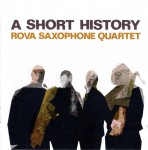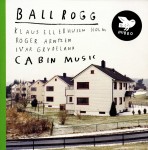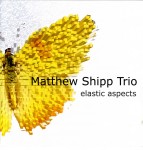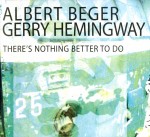One of jazz’s watershed musical creations, John Coltrane’s 1965 performance of Ascension marked his commitment to Free Jazz and has since served as a yardstick against which saxophone-centred large ensemble improvisations are measured. On September 7 at the River Run Centre’s main stage, one of the highpoints of this year’s Guelph Jazz Festival is a reimagining of Coltrane’s masterwork by the Bay area-based ROVA Saxophone Quartet and guests. Not only is the ensemble gutsily tackling the suite, but its arrangement takes Coltrane’s all-acoustic piece for five saxes, two trumpets and rhythm section and reconfigures it so that ROVA’s four saxes plus one trumpeter interact with two drummers, two violins, electric guitar and bass plus electronic processing.
 You can get an idea of ROVA’s style of sonic daring-do on A Short History (Jazzwerkstatt JW 099 www.jazzwerkstatt.eu). Referencing all sorts of reed writing from R&B vamps to atonal serialism, the 35-year-old quartet made up of soprano and tenor saxophonist Bruce Ackley, alto and sopranino saxophonist Steve Adams, baritone and alto saxophonist Jon Raskin and tenor and sopranino saxophonist Larry Ochs show its versatility throughout. Especially germane and related to Ascension is a section on Part 2 of the Ochs-composed Certain Space sequence when he corkscrews an intense, stop-time solo into a strident collection of irregular polyphony and slap-tongue invention from the other saxes with the authority of Coltrane’s sax choir from 47 years earlier. That’s merely one highlight of this tour-de-force which outline’s the band’s other influences with tracks dedicated to improv pianist Cecil Taylor and notated composers Giacinto Scelsi and Morton Feldman. The Scelsi section dramatically contrasts bagpipe-like slurs from the soloists with impressionistic harmonies from the other reeds modulating through different modes and tones. Although other sequences in the Taylor section expose sinewy tessitura and staccato reed bites in call-and-response fashion, Part 3, for Feldman, is unsurprisingly moderato and leisurely, introduced and completed by air blown through the horns’ body tubes without key movement, yet lyrically balanced throughout as each saxophone’s timbre is clearly heard within the close harmonies.
You can get an idea of ROVA’s style of sonic daring-do on A Short History (Jazzwerkstatt JW 099 www.jazzwerkstatt.eu). Referencing all sorts of reed writing from R&B vamps to atonal serialism, the 35-year-old quartet made up of soprano and tenor saxophonist Bruce Ackley, alto and sopranino saxophonist Steve Adams, baritone and alto saxophonist Jon Raskin and tenor and sopranino saxophonist Larry Ochs show its versatility throughout. Especially germane and related to Ascension is a section on Part 2 of the Ochs-composed Certain Space sequence when he corkscrews an intense, stop-time solo into a strident collection of irregular polyphony and slap-tongue invention from the other saxes with the authority of Coltrane’s sax choir from 47 years earlier. That’s merely one highlight of this tour-de-force which outline’s the band’s other influences with tracks dedicated to improv pianist Cecil Taylor and notated composers Giacinto Scelsi and Morton Feldman. The Scelsi section dramatically contrasts bagpipe-like slurs from the soloists with impressionistic harmonies from the other reeds modulating through different modes and tones. Although other sequences in the Taylor section expose sinewy tessitura and staccato reed bites in call-and-response fashion, Part 3, for Feldman, is unsurprisingly moderato and leisurely, introduced and completed by air blown through the horns’ body tubes without key movement, yet lyrically balanced throughout as each saxophone’s timbre is clearly heard within the close harmonies.
 That same night, Ascension guitarist Nels Cline and others will join members of Norway’s Huntsville trio at St. George’s Church for its unique mixture of improvisation tempered with electronic impulses and influenced by folk and rock music textures. Huntsville’s Ivar Grydeland, who plays electric, acoustic and pedal steel guitars plus banjo and electronics with bassist Tonny Kluften and percussionist Ingar Zach in that band, shows off his zesty mix of spidery licks, resonating twangs and droning pulses with Ballrogg, another Norwegian combo on Cabin Music (Hubro CD 2515 www.hubromusic.com). With that trio filled out by alto saxophonist/clarinettist Klaus Holm, who adds electronics and field recordings to the mix, and bassist Roger Arntzen, the disc is a close cousin to what Huntsville creates, albeit with more overdubbing, and, with Grydeland frailing his banjo as often as he strums his guitar, more country-folksy. Probably the most descriptive track is Sliding Doors which manages to deftly balance clarinet glissandi, ringing banjo flanges and a powerful walking bass line. Before the result takes on too much of a rural interface however, the trio’s juddering interaction is meticulously intercut with previously prepared jagged guitar flanges and sluicing bass lines.
That same night, Ascension guitarist Nels Cline and others will join members of Norway’s Huntsville trio at St. George’s Church for its unique mixture of improvisation tempered with electronic impulses and influenced by folk and rock music textures. Huntsville’s Ivar Grydeland, who plays electric, acoustic and pedal steel guitars plus banjo and electronics with bassist Tonny Kluften and percussionist Ingar Zach in that band, shows off his zesty mix of spidery licks, resonating twangs and droning pulses with Ballrogg, another Norwegian combo on Cabin Music (Hubro CD 2515 www.hubromusic.com). With that trio filled out by alto saxophonist/clarinettist Klaus Holm, who adds electronics and field recordings to the mix, and bassist Roger Arntzen, the disc is a close cousin to what Huntsville creates, albeit with more overdubbing, and, with Grydeland frailing his banjo as often as he strums his guitar, more country-folksy. Probably the most descriptive track is Sliding Doors which manages to deftly balance clarinet glissandi, ringing banjo flanges and a powerful walking bass line. Before the result takes on too much of a rural interface however, the trio’s juddering interaction is meticulously intercut with previously prepared jagged guitar flanges and sluicing bass lines.
 Negotiating the tightrope between staccato and lyrical in his playing is the forte of pianist Matthew Shipp, whose duo with saxophonist Darius Jones is the other half of the double bill at Cooperators Hall. Elastic Aspects (Thirsty Ear TH 57202.2 www.thirstyear.com), with long-time associates bassist Michael Bisio and drummer Whit Dickey however, shows that Shipp’s improvising can be as mercurial in the standard jazz piano trio setting as well. With each of the 13 aspects of this suite stretching so that they adhere to one another, the effect is wholly organic, not unlike the recording of Ascension. With Dickey’s nuanced patterning and Bisio’s buzzing, often bowed, sometimes walking bass lines beside him, Shipp skilfully moves through the piano language. A track like Explosive Aspects balances on ringing, left-handed syncopation, while the subsequent Raw Materials evolves like a baroque invention with leaping, high-pitched notes carefully shaded as they jostle with pedal-point bass line until the theme finally breaks free into rubato pulsing. There are internal string plucks and harpsichord echoes in Shipp’s playing as well. With tremolo, lyrical and sometimes impressionistic patterning on show, the trio maintains the swinging centre of jazz while subtly or overtly charting new experiments and explorations.
Negotiating the tightrope between staccato and lyrical in his playing is the forte of pianist Matthew Shipp, whose duo with saxophonist Darius Jones is the other half of the double bill at Cooperators Hall. Elastic Aspects (Thirsty Ear TH 57202.2 www.thirstyear.com), with long-time associates bassist Michael Bisio and drummer Whit Dickey however, shows that Shipp’s improvising can be as mercurial in the standard jazz piano trio setting as well. With each of the 13 aspects of this suite stretching so that they adhere to one another, the effect is wholly organic, not unlike the recording of Ascension. With Dickey’s nuanced patterning and Bisio’s buzzing, often bowed, sometimes walking bass lines beside him, Shipp skilfully moves through the piano language. A track like Explosive Aspects balances on ringing, left-handed syncopation, while the subsequent Raw Materials evolves like a baroque invention with leaping, high-pitched notes carefully shaded as they jostle with pedal-point bass line until the theme finally breaks free into rubato pulsing. There are internal string plucks and harpsichord echoes in Shipp’s playing as well. With tremolo, lyrical and sometimes impressionistic patterning on show, the trio maintains the swinging centre of jazz while subtly or overtly charting new experiments and explorations.
 There are no guitars in sight the next afternoon at a double bill at River Run Centre’s Cooperators Hall, although Miya Masaoka’s multi-string koto may make up for that as she plays with bassist Reggie Workman and percussionist Gerry Hemingway. A long-time festival visitor, Hemingway’s recent CD There’s Nothing Better to Do (OutNow Records ONR 007 www.outnowrecordings.com) with tenor and soprano saxophonist Albert Beger demonstrates the drummer’s skill in the sort of duo format that Coltrane excelled in during his latter career. The near-naked improvising of this first-time meeting between American drummer and Israeli saxophonist demonstrates the universality of expression. Using his hands as often as sticks and brushes, Hemingway is as likely to come up with a tom-tom rhythm, produce a ratcheting scratch on his kit’s sides or tap a small bell as he is to let loose with full-force ruffs and drags. Beger responds to these understated rhythms in kind, with hoarse-throated vibrations, ragged tongue fluttering or surprisingly aligned trills, which are as often chromatic as cascading. Using both his horns throughout, the saxophonist’s moderate tones can be graceful and emotional as Hemingway’s beats gracefully scurry around them. However elsewhere ragged, altissimo reed bites stridently operate in tandem with the drummer’s blunt flams and tough backbeat. With bravura timing the two show how easily they can move from cacophonous vibrations to an arrhythmic but bluesy output on Missing You or on the title track, speedily layering freak reed notes and circular slurs plus clashing cymbals and incisive shuffle beats into a parallel exposition that is as moving as it is staccato.
There are no guitars in sight the next afternoon at a double bill at River Run Centre’s Cooperators Hall, although Miya Masaoka’s multi-string koto may make up for that as she plays with bassist Reggie Workman and percussionist Gerry Hemingway. A long-time festival visitor, Hemingway’s recent CD There’s Nothing Better to Do (OutNow Records ONR 007 www.outnowrecordings.com) with tenor and soprano saxophonist Albert Beger demonstrates the drummer’s skill in the sort of duo format that Coltrane excelled in during his latter career. The near-naked improvising of this first-time meeting between American drummer and Israeli saxophonist demonstrates the universality of expression. Using his hands as often as sticks and brushes, Hemingway is as likely to come up with a tom-tom rhythm, produce a ratcheting scratch on his kit’s sides or tap a small bell as he is to let loose with full-force ruffs and drags. Beger responds to these understated rhythms in kind, with hoarse-throated vibrations, ragged tongue fluttering or surprisingly aligned trills, which are as often chromatic as cascading. Using both his horns throughout, the saxophonist’s moderate tones can be graceful and emotional as Hemingway’s beats gracefully scurry around them. However elsewhere ragged, altissimo reed bites stridently operate in tandem with the drummer’s blunt flams and tough backbeat. With bravura timing the two show how easily they can move from cacophonous vibrations to an arrhythmic but bluesy output on Missing You or on the title track, speedily layering freak reed notes and circular slurs plus clashing cymbals and incisive shuffle beats into a parallel exposition that is as moving as it is staccato.
Overall 2012 promises to be a banner year for the Guelph Jazz Festival (September 5 to 9). And that’s not even mentioning the dusk-to-dawn Nuit Blanche late Saturday encompassing more unexpected sounds. Full details can be found at www.guelphjazzfestival.com.



